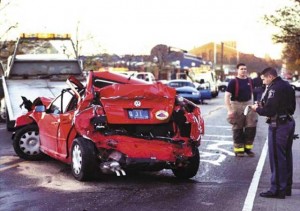After a decade of sharp declines, highway fatalities increased unexpectedly during the first quarter of 2012, according to preliminary government data – and a warm winter may catch at least some of the blame.
Traffic deaths surged a substantial 13.5% for the three-month period, according to a preliminary analysis by the National Highway Traffic Safety Administration. That’s a significant reversal of recent trends. Last year, roadway fatalities fell 1.7%, to the lowest overall total in more than 60 years. And, on a per-mile basis, it was an all-time record.
For the first quarter of this year, NHTSA says 7,360 people were called in traffic accidents, up from 6,720 the year before. If that figure holds it would work out to about 1.10 deaths per 100 million miles driven compared to 0.98 deaths the year before.
Despite bad winter road conditions in many parts of the country, the first quarter generally sees a decline in traffic deaths because people drive less. And, in general, American motorists have been curtailing driving, in recent years, to compensate for rising fuel prices.
But there was a 1.4% surge in the number of miles Americans drove during the first quarter of 2012, and that may have been encouraged by the unusually mild winter that brought spring and even summer-like temperatures to much of the country.
Noting the first quarter was “unseasonably warmer than usual in most areas of the country,” a NHTSA statement cautioned that, “Consequently, the fatality rate for the first quarter should not be used to make inferences for the fatality rate for the whole of 2012.”
Certainly, safety advocates hope that’s the case. The U.S. traffic death total has been plunging sharply for the last seven years. As recently as 2005, there were 43,510 deaths on U.S. roads – a figure that includes pedestrian fatalities. But last year’s number came in at 32,310, the lowest figure since 1949. On a per-miles-driven rate it was the lowest number since the government began keeping records in 1921.
Travel also fell last year by 1.2%, year-over-year, to 2.963 trillion miles driven by American motorists. That was the lowest figure since 2003. But Americans drove an extra 9.7 billion miles during the mild first quarter, a 1.4% increase over January to March 2011.
NHTSA’s disconcerting numbers may actually understate the problem. Using its own data the National Safety Council estimated first-quarter 2012 traffic deaths rose to 8,170, up from 7,270 a year earlier.
Whatever the final number, researchers will clearly be examining their data to determine the precise cause of, most likely, causes. Safety experts have been worried about increasing problems with driver distraction, something U.S. Secretary of Transportation Ray LaHood has described as an “epidemic,” responsible for as much as one in 11 fatalities on American roads.


No doubt driver distraction is a significant part of the problem, but I would think that crowded interstates and secondary roads, roads that are archaic given the demands of high speeds, are a bigger part of the problem. As a nation we keep putting off the repair of these roads and indeed the crucial updates that need to be made to our interstate system because of the interference of the Grover Norquist, no-new tax crowd. NHTSA can blame these deaths on distraction, because that doesn’t cost them any money or political capital, but the real results will be when our country decides to repair the roads and bridges, and build safer, wider interstates with better signage and GPS features installed in all cars, to say nothing of accident-avoidance features being installed in all new cars. In an election year, Lahood won’t own up to this, but if Obama is elected to a second term, he and his agencies will be a lot freer to advocate for a lot of things, given that he will be a President not running for another term.
Perhaps, but he will also be a lame duck likely facing at least one chamber on the Hill controlled by his rivals. Will the GOP be singularly focused on the 2016 election, should Obama win re-election or decide to go a more bipartisan road? Likely we’ll have to see how the November voting goes.
Paul A. Eisenstein
Publisher, TheDetroitBureau.com